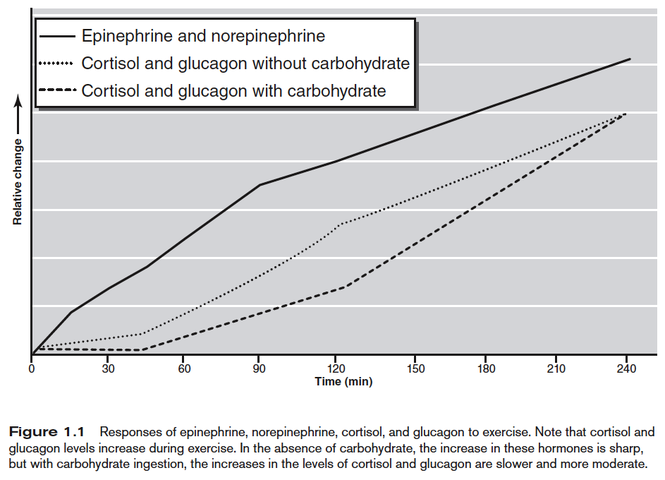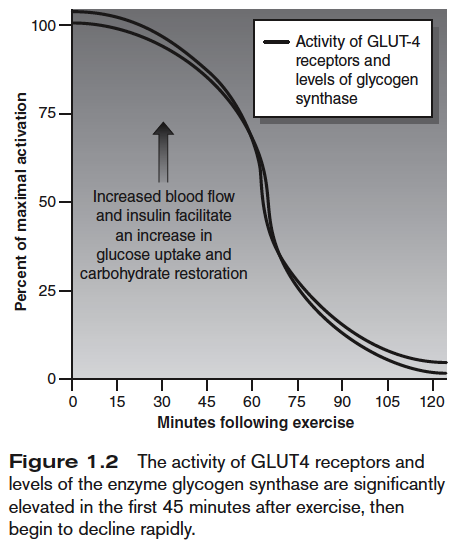Physiological basis for nutrient timing
This is an excerpt from Performance Nutrition by Krista G Austin,Bob Seebohar.
Several lines of scientific evidence provide the basis for timing nutrient ingestion. The body's response to exercise in terms of hormone control and muscle function and its response to different types of carbohydrate and protein create the foundation for understanding how timing nutrition specifically to the muscles' functional needs is optimal for an athlete. Together, these responses produce the greatest evidence, which is the effect on body composition, glycogen stores, protein balance, and rehydration.
Hormonal Control
Hormonal responses to exercise are dependent on training intensity, training duration, training volume, and the fitness level of the person. The key hormones involved in the regulation of muscle function are epinephrine, norepinephrine, insulin, cortisol, and glucagon. Figure 1.1 shows how these hormone levels change with increasing exercise duration. The hormones epinephrine and norepinephrine are called neurotransmitters and are responsible for stimulating the breakdown of stored fat and glycogen for use as energy during exercise. With the onset of exercise, epinephrine and norepinephrine rapidly increase.

Insulin is the hormone responsible for the integration of fuel metabolism at rest and during exercise. The levels of insulin determine how much of the body's needed energy will be derived from the breakdown of fat, carbohydrate, and protein. When an athlete is in a fasted state, less insulin is produced, and fats and proteins are recruited to provide fuel for the body. With food consumption, insulin levels increase so that consumed carbohydrate, fat, and protein can be utilized for fuel or stored by the body's tissues. During exercise, insulin allows glucose to be readily used by the body's working tissues. The sensitivity of the muscle cells to insulin increases when exercise is stopped.
The actions of cortisol and glucagon are dependent on the amount of glucose in the blood and on energy availability in the body. Glucagon is increased in response to low blood glucose levels; it is responsible for breaking down carbohydrate stored as glycogen in the liver and facilitating the conversion of amino acids to glucose. Cortisol is the hormone that facilitates the synthesis of glucose from the breakdown of protein and fat in times of a reduced energy state. When blood glucose levels drop too low during exercise, glucagon is increased to promote glycogen release from the liver and, if necessary, works with cortisol to promote the synthesis of glucose from free fatty acids and amino acids.
Muscle Regeneration
A number of factors—from enzymes, to blood flow, to receptors on the muscle cell, to hormone action—are elevated to the greatest extent in the first 45 minutes after exercise stops. Over the next several hours, these factors slowly return to resting levels; thus, the 45 minutes after exercise is considered a window of opportunity for the ingestion of foods that will promote muscle recovery through glycogen replenishment and rehydration.
This response is highly facilitated by the enzyme glycogen synthase and a transporter known as GLUT4, both of which are responsive to insulin and are significantly elevated after exercise. Together glycogen synthase and GLUT4 enhance the uptake of carbohydrate and improve glycogen storage. These actions are further facilitated through insulin, which facilitates carbohydrate uptake and increases the rate of muscle blood flow. This not only helps deliver nutrients to the muscles but also aids in the elimination of metabolic waste that was produced during exercise. In the 45 minutes immediately after exercise, the activity of GLUT4 receptors and levels of glycogen synthase are maximally elevated, allowing insulin to facilitate carbohydrate restoration to the muscle cells and improve recovery from training (figure 1.2).

Types of Carbohydrate and Protein
The functionality of foods is covered in greater detail in chapter 4, but it is important to note here that intake of the right type of carbohydrate is significant evidence for timing nutrient ingestion. In addition, the timing of protein and the type available to the muscle are critical for optimizing adaptations from resistance and cardiovascular training.
As mentioned, insulin is an important hormone in the muscle response after exercise. The rate of posttraining muscle glycogen synthesis has been shown to be proportional to the increase in blood insulin levels. Athletes should therefore select the type of carbohydrate they consume based on how quickly glycogen stores must be replenished, which depends on the amount of time between training sessions. When the next training session will begin determines the type of carbohydrate and insulin response that is desired. For most athletes, muscle glycogen can be sufficiently restored through the use of low to moderate glycemic carbohydrates that do not require a significant spike in insulin and will steadily restore glycogen. This approach will also help to minimize gains in body weight. An example of a postexercise snack that would provide this response is whole wheat bread with almond butter and banana. When glycogen restoration must happen quickly, the best types of carbohydrate to stimulate an increase in blood insulin levels are those that evoke a high glycemic response because of their rapid conversion to glucose in the blood. An example of a postexercise snack that would provide this response is white bread with banana and honey. All are made of simple sugars and have minimal fiber content so that digestion and absorption by the body can be done quickly. The more readily glucose can become available to the working muscles, the faster the rate of glycogen resynthesis can occur and recovery can begin. This is frequently the case for athletes who perform multiple prolonged training bouts within a day or, in the case of a weight-classified sport, athletes who must replenish glycogen stores from having cut weight.
Glycogen restoration may be further enhanced through the ingestion of protein with carbohydrate. This is attributed to the optimization of the insulin response and the suppression of cortisol, which speeds the muscle's recovery process. The availability of essential amino acids (such as those found in dairy and meat products) before and after training is also an important factor in maintaining or increasing muscle protein synthesis. Thus, it is important that the protein source used contain all the essential amino acids. Depending on an athlete's food preferences, this can be accomplished by consistently consuming foods in the daily diet that contain all the essential amino acids or by ensuring that the pre- and posttraining snack contains foods that are a good source of essential amino acids.
Body Composition
Most athletes seek to optimize the ratio of muscle and fat mass in the body because of the positive relationship this has with performance. Studies assessing the patterns of food intake by athletes have shown that eating meals at regular intervals is most optimal for maintaining a high level of muscle mass and a lower level of body fat. These same studies show that most athletes eat infrequently and consume a majority of their calories in a large meal at the end of the day. This leads to large rises in blood glucose that in turn encourage the storage of fat mass. Furthermore, this eating pattern delays energy restoration, and so the body utilizes muscle proteins to make and maintain blood glucose levels, leading to a decrease in muscle mass. For the body to optimize its composition, blood glucose needs to stay stable. When an athlete consumes the energy expended in a training session through frequent eating that revolves around training, the muscles are functionally available and ready to absorb the nutrients ingested, thus helping to maintain stable levels of glucose in the body. Timing nutrient ingestion revolves around the supply and demand for energy production by the working body, which enhance body composition. Improvements in body composition result in an improved ratio of muscle mass to fat mass and in turn directly result in an improved work capacity.
Learn more about Performance Nutrition.
More Excerpts From Performance NutritionSHOP

Get the latest insights with regular newsletters, plus periodic product information and special insider offers.
JOIN NOW


